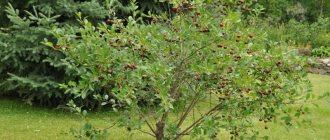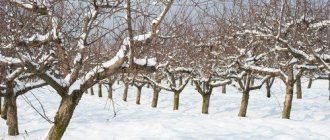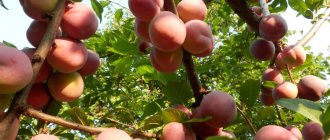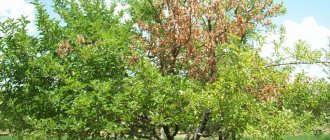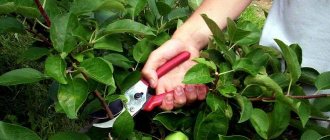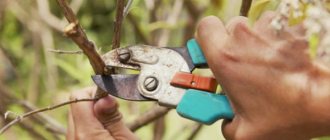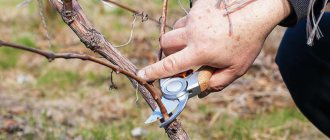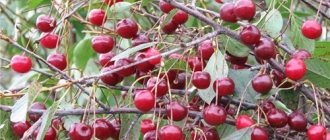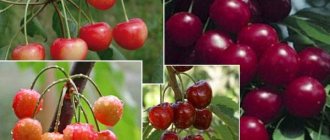The first pruning of the cherry tree should be done immediately after planting the seedling. In the future, this procedure should become a habit for every gardener who dreams of a bountiful harvest.
Cherry is one of those crops whose crown thickens quickly. And the denser it is, the worse the harvest will be and the smaller the fruits. So why not help the plant? Moreover, mastering the science of proper pruning of cherries is not so difficult.
Cherry trees can be pruned in spring or autumn, but more often this is done in the spring, before the buds have yet begun to bloom.
Pruning young cherries - first year
The cherry tree pruning scheme is quite simple if you are not going to give the crown any special shape. It all starts with shortening the crown of the annual tree by 18-22 cm. This is done not in early spring, but in mid-June, when young growths slowly begin to appear from the buds that you left.
First, you need to visually identify the so-called standard zone on the seedling. Usually this is a part of the seedling from the root collar (in other words, from the soil level) to a height of 45-50 cm. The trunk must be bare: all shoots on it that grow from the buds must be removed immediately. And from those shoots that grow above the trunk zone, you should choose five of the strongest and evenly distributed along the cardinal points. These will be the skeletal branches of your cherry tree. Be sure to tie the topmost shoot, especially if it is a little crooked, to a peg.
It is better to stick the pegs into the ground when planting the seedling - this way there is no risk of damage to the root system.
All shoots that are located between those that you have chosen as skeletal ones must be cut into a ring, without leaving a stump.
Pruning is not only a series of sequential actions, but also their correct execution. Learn to trim so that there are no stumps left. They look harmless, but as the tree grows they can begin to rot, fall off, and in their place hollows almost always form. An infection can easily penetrate them and destroy the tree. Don’t forget about garden varnish, it is a gardener’s friend and faithful assistant - for any type of pruning, at any time of the year, all cuts must be covered with it.
In the future, it is important to constantly regulate the growth of side shoots. Ideally, those located higher should be shorter than those growing lower. Remember the Christmas tree principle? Same thing with cherries. This problem can be solved by simply pinching the tops of the upper shoots. After this, the branches will begin to grow to the sides and will not stretch.
Why prune cherries?
Proper pruning of cherries affects not only its decorative appearance, but also abundant fruiting in the future. If a tree is not pruned, over time its crown thickens, its yield drops and it becomes vulnerable to disease and pest damage. So, when is the best time to prune cherries and how to perform this procedure correctly so as not to harm the tree.
Cherry trees are characterized by increased upward growth and long, inflexible branches. Annual growth can reach 1-1.5 m. If the tree is not pruned, its height can reach 6-8 and even 12 m. Such a tall tree is not only problematic to care for, it is almost impossible to harvest from it. Therefore, cherry branches need to be shortened in time, while you can still use the power of your own hands instead of pruners and hacksaws.
Pruning cherry seedlings in the second year
From the total mass of shoots, select 5-6 well-developed, strong branches that extend from the main trunk at an angle of 40° or more (the more, the better). It is these shoots that will form the skeleton of the crown.
Do not forget about the subordination of those shoots that you have chosen to the central conductor - the ends of these branches should be at least 25-30 cm below its top. All other shoots should be shortened by no more than 8-10 cm. But if in the future you If you notice that they interfere with each other or thicken the crown, then they can be cut into a ring.
This is what a cherry seedling looks like after pruning in the 2nd year (left) and 3rd year (right)
Timing of pruning
Farmers make most mistakes due to the incorrect timing of the procedure. Here you need to focus on the speed of movement of the sap in the branches - it should be minimal. If you cut cherry branches at the wrong time, then all the juice contained in the shoots goes away. The most obvious sign of slow sap flow is opening and swollen buds. They should not yet bloom, but are clearly visible to the naked eye on the bushes.
The deadline for pruning varies in each region. So in regions with a warm, mild climate, the procedure is carried out around the middle or end of March. For the middle zone, the optimal time is mid-April, and for the fourth part of the country - no earlier than the end of April or even the beginning of May. If the winter in the region was not snowy and cold, then most likely the tree was a little frozen, which means that the branches need to be trimmed a little later than usual, by 2-3 weeks.
The deadline depends on the phase of the moon, so in order to cause minimal damage to the cherry, you need to prune only on certain days of the month.
Table 1 Date for pruning cherries according to the lunar calendar
| Month | Favorable days of the month |
| March | 3, 4, 9-14, 16, 23, 27, 28, 29 |
| April | 2, 3, 7-13, 15, 26-29 |
| May | 2, 3, 8-13, 15, 27-30 |
| June | 1, 5-11, 13, 14, 20, 22, 29 |
| July | 4, 6-10, 12, 20, 21, 28 |
Pruning should be done during the waning moon phase, since this time is the most favorable. During this period, all the movement juices inside the tree branches rush down, from the top to the roots.
The main pruning is carried out in the spring: at this time the crown is formed for future fruiting. Summer pruning of the crop in June and July is possible, but is rather of an auxiliary nature. During the hot period, it is advisable to carry out minor corrective treatment of the crown, removing mainly damaged, diseased branches, dry branches - these parts of the tree are already dead, so there will definitely be no harm from their removal, only benefit. If you cut young shoots in June and July, the cutting will take a very long time.
Pruning is carried out in dry, windless weather, preferably on a warm day, then the amount of resin coming out of the cut is minimized.
Cherry trimmings in the fourth year
In the fourth year, you need to fight against thickening, because young cherry trees grow quite actively. Remove shoots growing deep into the crown and ensure compliance with the central conductor (cutting off those that are equal to it in length or have outgrown). As in the previous year, from the grown young shoots, leave 1-2 that are most well located and do not thicken the crown.
Gardeners often ask the question - what to do with shoots that hang down? In cherries, by the way, this phenomenon is common. We answer: first they need to be lifted and tied to a higher shoot. If this fails, you can delete them.
The need for pruning
Beginning gardeners are often afraid to form a crown and think that nothing bad will happen, but this is not so. After years of cultivation, the yield of the crop will decrease significantly, and so will the lifespan of the tree itself. As a result, due to heavy load, it will die much earlier than the one that was regularly pruned. Pruning has several undeniable advantages:
- improving the taste of berries. If you remove excess unnecessary branches, the fruits increase in size and become tasty;
- rejuvenation. Timely pruning of shoots can extend the life of a crop by several years;
- reduction in infections. When pruning, first of all, old damaged shoots are removed, but they can become infected and affect young ones;
- increased fruiting. If you prune a tree correctly, you can double the yield;
- attractiveness. A formed symmetrical crown looks much more attractive than a tree with shoots randomly sticking out in different directions.
Undoubtedly, the procedure has many advantages, and when growing cherries it should be carried out, if possible, annually.
How to carry out anti-aging pruning of cherry trees?
As trees age, just like people, problems begin. In cherries, for example, the growth rate decreases, shoots become bare, fruits form only at the edge of the crown, and the lower branches dry out. All this is a signal that it is time to radically rejuvenate the tree.
With such pruning, they are guided by the intensity of growth in recent years, and if it was weak, the growth is removed without sparing, to the level of four or seven-year-old wood, trying to make all cuts on the side branch (so that new shoots grow not inside, but outside the crown, freeing center). Do not forget to remove with a ring cut all the shoots that thicken the center of the crown.
After such pruning, the cherry can literally “shoot out” shoots and form many tops (they grow vertically upward and in this form will not bear fruit). There is no need to try to remove all the tops; it is better to try to bend them, tying them to the lower shoots, or shorten them so that they begin to grow sideways.
Do not put off pruning the cherry tree “for later” and do not let the tree’s growth take its course. Remember - timely pruning not only increases the yield and extends the productive life of the tree, but also saves it from many diseases and pests.
When to prune cherries
Photo gardenerdy.com
Typically, the period suitable for this skincare procedure is the end of July and the first half of August. Since cherries bear fruit on last year's shoots, pruning after fruiting has the most favorable effect on the yield, number and size of next year's berries.
Choose a sunny day, dry and calm weather for pruning. In such conditions, wounds caused to trees by pruning heal faster and the risk of infection by pathogenic bacteria and fungi, the spores of which are easily carried by wind and raindrops, is minimal.
Immediately after pruning, the cut areas should be treated with RanNet or BlagoSad garden paste. You can use emulsion paint by adding any fungicide to it.
Preparation for pruning
To carry out the procedure as competently as possible, you need to stock up on gardening tools in advance:
- pruning shears They cut thin shoots up to 25 mm;
- with a sharp knife. You will need it to clean up the cuts;
- lopper. The tool is useful for cutting thick large branches with a diameter of 2-3 cm, located deep in the crown;
- garden saw. It will help get rid of shoots of any thickness.
Attention! All garden tools intended for pruning must have sharp, durable blades. It is necessary to choose tools such that the cutting parts located at the ends are slightly narrowed. Then you can get to the hard-to-reach part of the cherry crown.
In addition to equipment, you need to stock up on disinfectants. During pruning, infections and fungal spores can get into the cut site, so before carrying out the procedure you need to treat the tools and the shoots themselves in any available way:
- wipe with ethyl alcohol;
- treat with a 5% solution of copper sulfate;
- spray with a weak solution of pink potassium permanganate.
Do not forget to follow safety precautions, so the gardener will need thick gloves and glasses to protect his eyes and hands. It is convenient to carry out the work from an attached stepladder, then you can trim even tall cherries.
WHAT YOU NEED TO CONSIDER WHEN CARING FOR CHERRY TREES
First of all, it is necessary to remember that the majority of cherry varieties are only partially self-fertile. Therefore, you need to plant at least two different varieties nearby to cross-pollinate them.
It is important to choose the right place for planting. Cherries need constant sunlight throughout the day. But at the same time it must be protected from any drafts and cold winds. Therefore, it is best to plant it in the sun near the southern wall of the house or a high fence.
Cherries, like all stone fruit crops, need soil that is fertile, loose, light and neutral (pH 7.0). They do not tolerate stone fruits and excessive moisture, so they cannot be planted in wetlands and low-lying areas. We already wrote about this in the article “Winter-hardy cherries.”
If the groundwater is closer than 1.3 m from the surface of the earth, then a small hill 45 cm high is formed under the seedlings. On acidic soils, neutralization is carried out with dolomite flour or crushed chalk three weeks before planting.
For cherries, planting holes are prepared with a depth of 60 and a diameter of 50 cm. Drainage made of fine crushed stone must be laid at the bottom. It is best if it is made of calcareous rocks with an alkaline reaction. Now they are imported to almost all regions of the country.
In each hole, along with fertile soil, add a bucket of sand and compost, phosphorus-potassium fertilizers, wood ash and two glasses of crushed eggshells or a solution of calcium chloride (at a concentration of 1:5 with water).
Cherries need calcium to form seeds inside the berry. If it is deficient, the ovaries will fall off and the berries will not form. For this reason, eggshells (or other calcinates) need to be applied twice more per season: during the flowering period and after the ovaries appear.
Also, twice a summer - in spring and autumn, a glass of dolomite flour or crushed chalk is poured into the tree trunk circles and shallowly embedded in the soil by loosening.
Cherries need organic and mineral fertilizers for normal growth and development. In the spring, plants are given nitrogen and potassium (all stone fruits need it in increased doses), otherwise there will be no good harvest. In the fall, phosphorus-potassium fertilizers and calcium (in any form) are applied during digging.
Twice a season - at the beginning of flowering and after setting the berries, additional fertilizing with liquid mullein is carried out (two shovels are dissolved in a bucket of water and the trees are watered at the rate of 5 liters for each).
Despite the fact that modern cherry varieties are practically not affected by fungal diseases, in the spring, after the leaves bloom, it is recommended to carry out a single treatment of all plants with a 1% solution of Bordeaux mixture.
In order for the cherry to better withstand winter frosts, moisture-recharging irrigation is carried out at the end of October, at the rate of 60 liters per tree. In November, it is imperative to whiten all the trunks and lower skeletal branches of cherry trees. This will protect them from spring sunburn and frost damage.
Since the wood of cherry trees is very fragrant and delicate (especially young ones), it is recommended to protect them up to a height of 1 meter with spruce branches, tying them to the trunk on all sides.
As you can see, caring for cherries is not at all difficult. And if you correctly comply with all the requirements of agricultural technology, then it will thank you with a large and tasty harvest.
Tools for work
Tools must be disinfected before pruning.
If you are interested in how to properly prune cherries in the fall, do not forget that the procedure requires only high-quality sharp tools. To avoid introducing infection into the wood tissues, they are first disinfected. Experienced gardeners advise preparing the following equipment:
Recent Entries
Lilac perennials that are beautiful, compact and do not crowd out other plants Why when buying seedlings you should not take the sellers’ word for it and how to determine the age of the plant using 3 signs Tomato seedlings have turned purple or whitish: why the color has changed and how to save the plants
- pruning shears for thin shoots;
- garden saw or hacksaw for thick branches;
- lopper for cutting off branches at a considerable height;
- garden knife for sanding cuts.
Cherry tree pruning patterns
The age of the cherry tree largely determines the type of pruning. Formative pruning is suitable for young trees. Mature trees are pruned to rejuvenate, increase productivity and as a disease prevention.
young tree
It is best to form a sparse tiered crown. The pruning scheme involves the following activities:
- After planting on the site, you need to cut off the top of the seedling, forming a standard. The central shoot is free from side branches. Its height should be 42 cm.
- In spring, all side shoots should be pruned, leaving 5 strong branches that grow from the main stem. If skeletal shoots cannot be selected in the first season, then the procedure is left for another year.
- On the three lower branches, two shoots of the second order are left at a distance of 38 cm. These branches are called semi-skeletal.
- Then the growth of the central stem is limited to a height of 3.4 meters. The result is a formed tree with 12 skeletal shoots.
Method of pruning an adult tree
To prevent the development of diseases and increase productivity, mature trees should be pruned. The work scheme involves the following actions:
- Be sure to remove dried, diseased and broken branches.
- If there are very dense areas, then thinning is carried out.
- For rejuvenation, you need to trim the skeletal shoots to the first stem branch.
- Young shoots that will appear in the new season are shortened by 6 cm.
Whitewashing cherries in early spring
It is better to bleach cherry trees in the fall. But if you did not do this, or the whitewash was washed away by rain and sleet, the procedure must be repeated. Moreover, this should be done in the second half of February - early March.
The fact is that whitewashing protects tree trunks from frost damage and sunburn, which usually occur at the end of winter. Sudden temperature changes - daytime plus and night minus, as well as the insidious first rays of the sun have a very negative impact on the condition of the tree trunk. To protect the plant, it must be treated with a whitening compound.
Whitewashing of cherry trees begins in early spring, when the air temperature is at least 5°C. For whitewashing, you can use special garden paints, or prepare a lime-based composition: mix 10 liters of water, 2.5 kg of slaked lime, 100-200 g of carpentry or wallpaper glue and treat the trunks and 1/3 of the skeletal branches of the tree with the solution.
It is better not to treat young trees with lime, but to give preference to a less aggressive chalk-based coloring composition or choose ready-made garden paint.
- When to renew whitewash on trees
We tell you when to whiten trees after winter and why it is important.
FOR EFFECTIVE CHERRY CARE – CHOOSE THE BEST VARIETIES
There are many varieties of cherries, but we offer you only the most productive, large-fruited ones with tasty, sweet and aromatic berries, and most importantly, resistant to all fungal diseases. In addition, all these varieties begin to bear fruit in the second or third year.
Debretseni Boterna (earliest), Lucina (very sweet), Biryusinka (early), Ural ruby (best pollinator for all varieties), Vladimirskaya (very productive), Brusnitsina (self-fertile), Groniasta (early), Izobilnaya (self-fertile), Ashinskaya (frost resistance up to – 48 degrees).
For beginner gardeners and those who cannot regularly care for their garden, we offer Bessey (sand). This low, unpretentious bush will bring you a good harvest of medium-sized (up to 3.5 g), sweet dark burgundy berries with a characteristic cherry aroma. You can eat them fresh, make jam from them, or make cherry wine.
Now that you know how to care for cherries, plant them in your garden and get a lot of pleasure from their delicate, fragrant berries. Moreover, you won’t have to wait long for the harvest. Full fruiting will begin in the third year!
